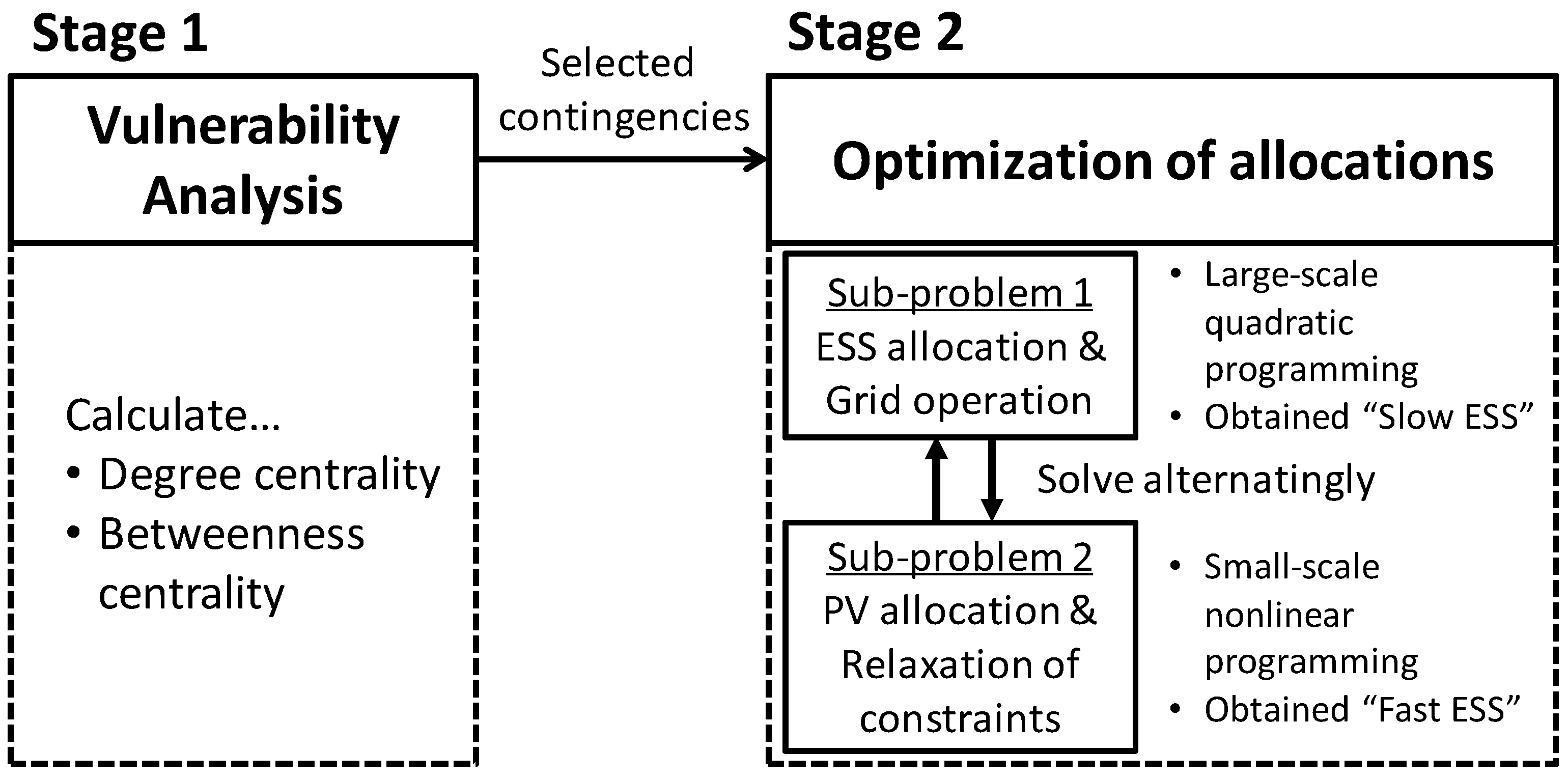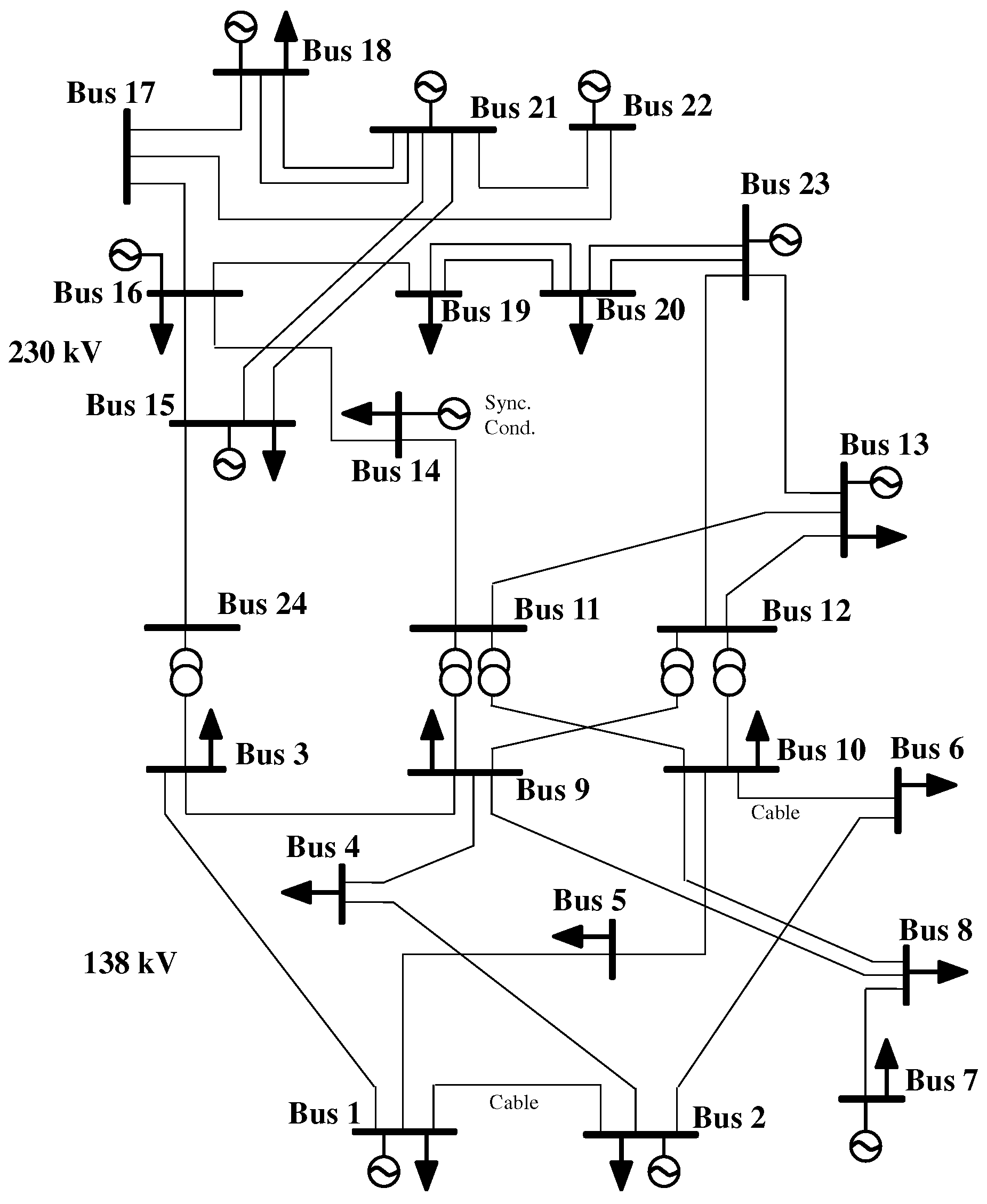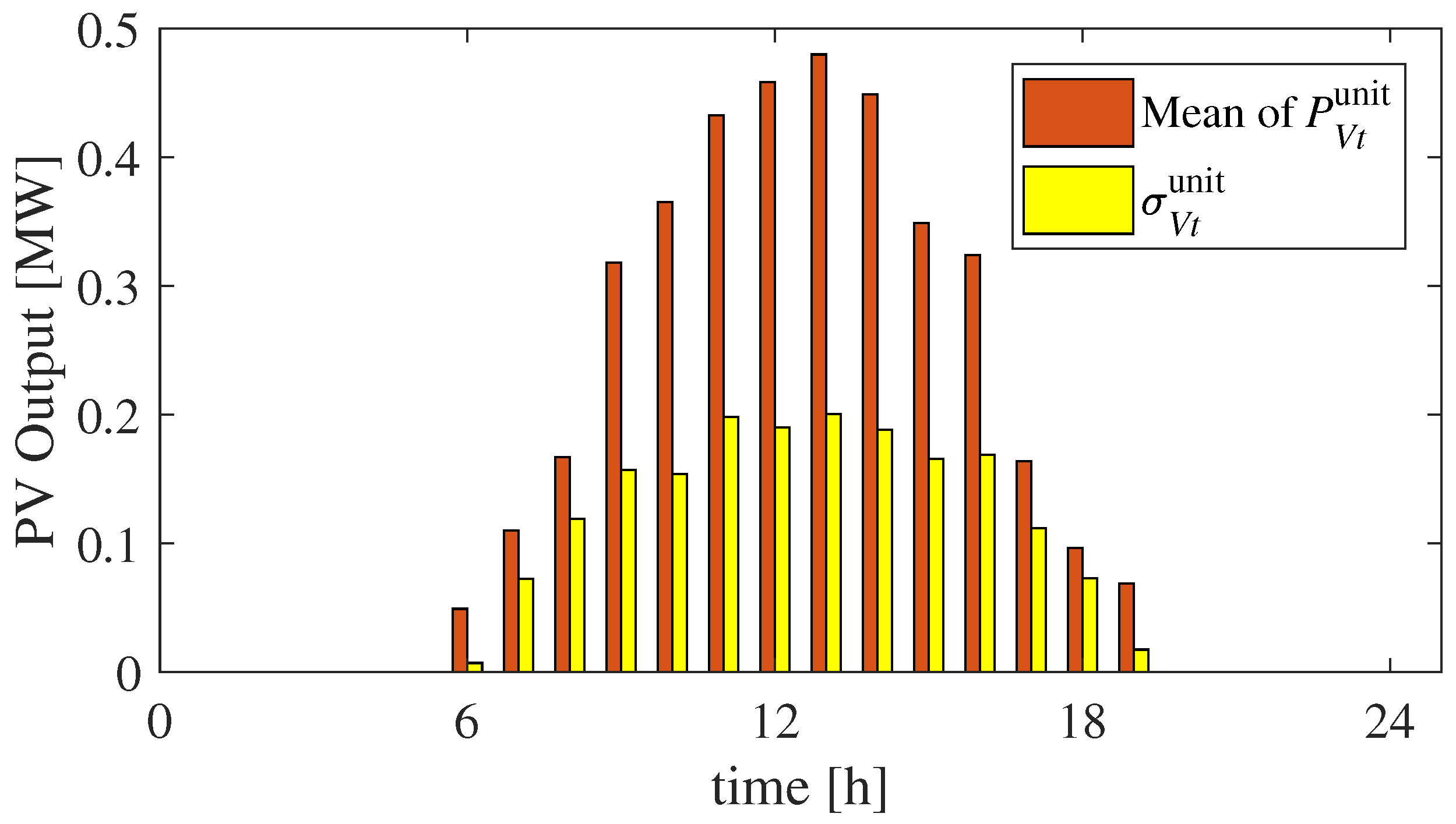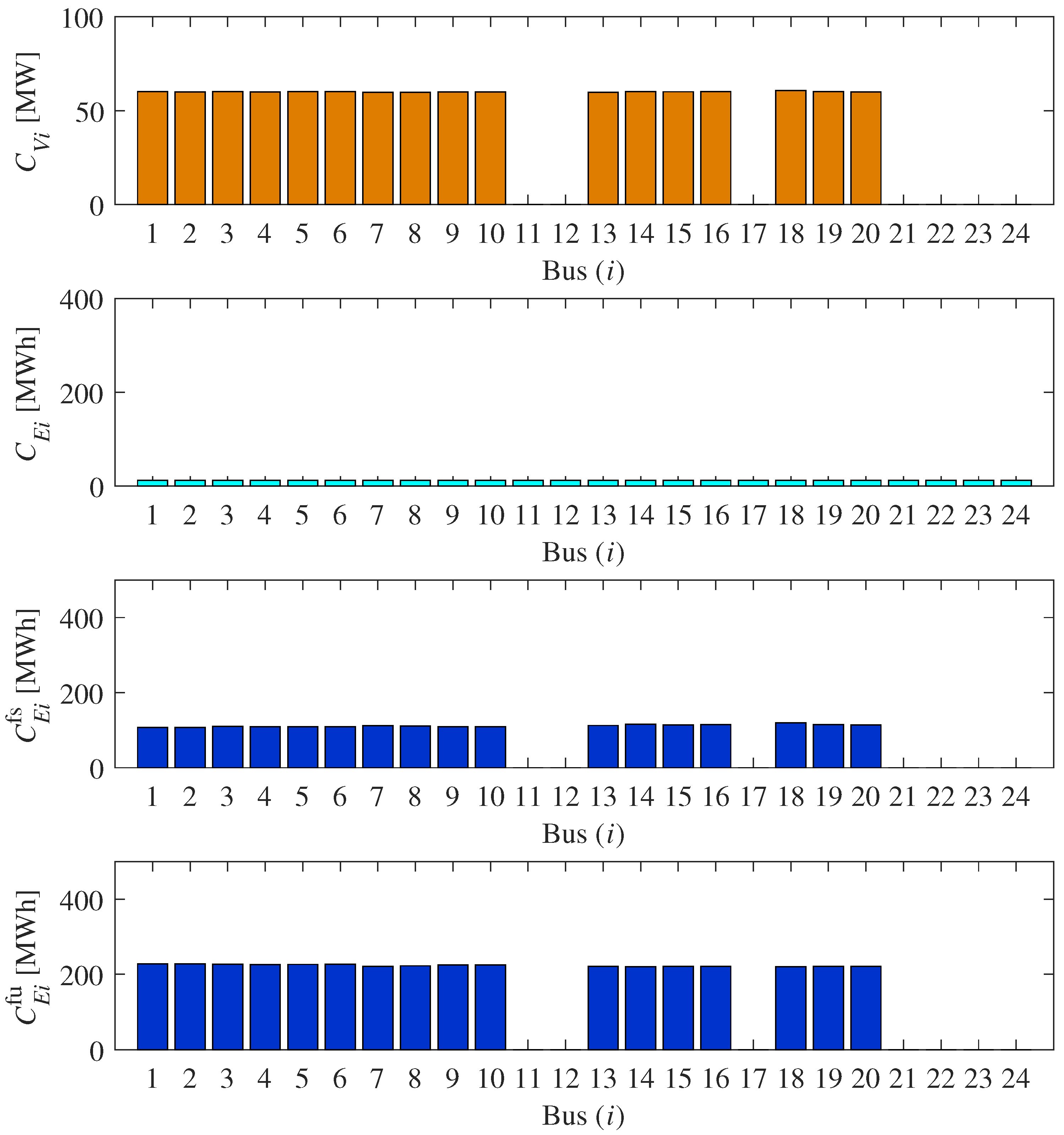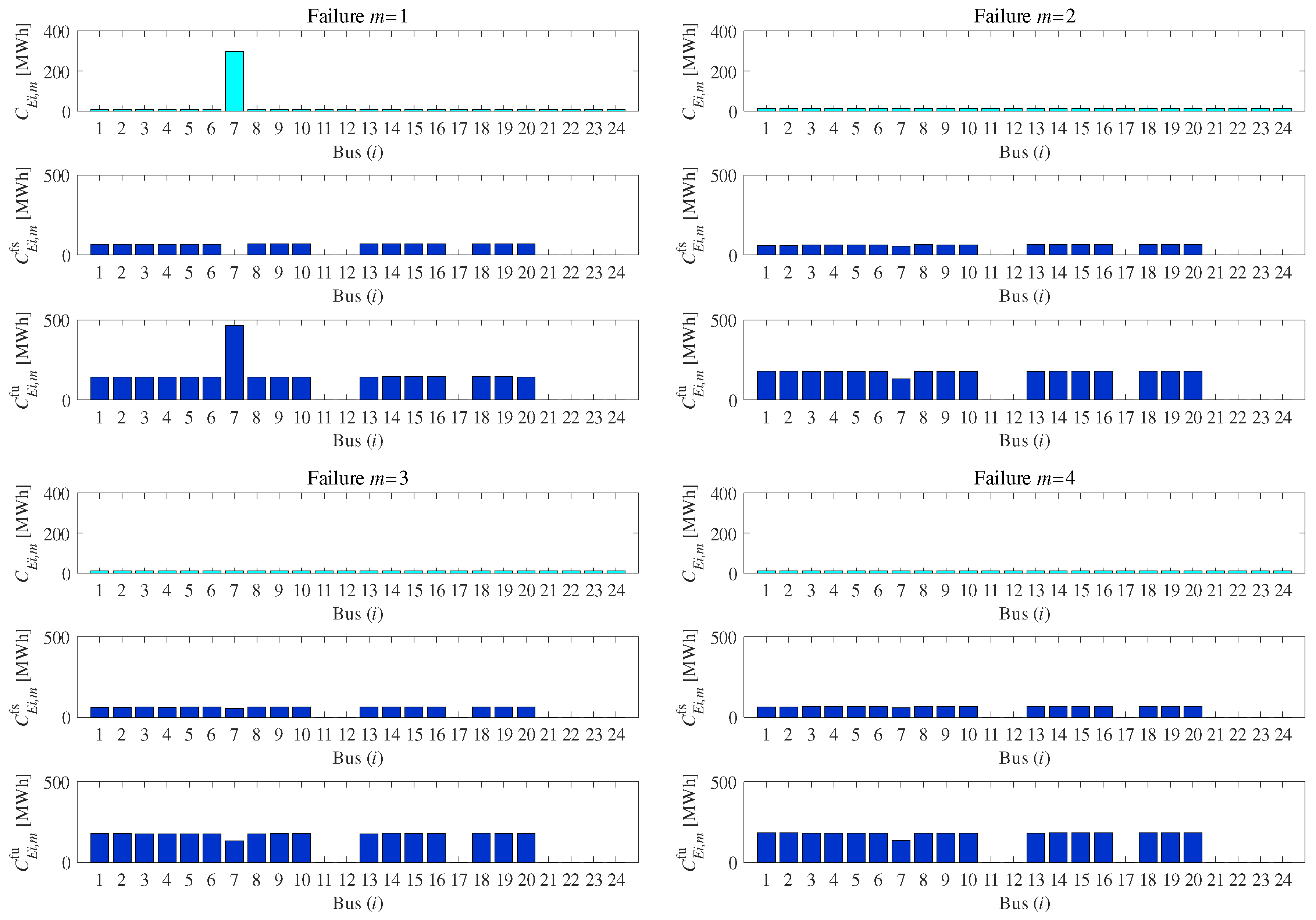1. Introduction
Grid operators require electric power systems with high fault tolerance because grid failures could have a severe impact from technical and economical viewpoints. Moreover, the importance of fault tolerance has been rising as the uncertainties in power systems become more significant. One of the causes of uncertainties is the increased installation of renewable energy systems (REs) such as photovoltaic systems (PVs) and wind power systems, because the outputs of REs depend on the solar radiance or wind velocity. These uncertainties could cause both power shortages and surpluses in power systems, which render power systems unstable. Several methods have been proposed to overcome the constraints of power shortage and surplus. In this study, the installation of energy storage systems (ESSs) in transmission systems is considered. Using ESSs such as batteries and pumped storage power plants, the issues of power shortage and surplus can be addressed by discharging and charging, respectively. In particular, the alleviation of power surpluses is increasingly becoming important because the curtailment of outputs of REs might prevent the installation of a large number of REs.
Many studies focused on the allocation of distributed generators (DGs) including REs and ESSs because siting and sizing of DGs have a major impact on the stability of power systems. These studies covered a broad range of topics in terms of objective functions, constraints, algorithms, and problem settings. Our study focuses on a typical trade-off problem for grid operators to minimize the equipment and operation costs of transmission systems in order to provide accessible services to their users and customers, while achieving both high fault tolerance and low costs.
Moreover, grid operators have to determine the allocations of REs and ESSs considering the expected contingencies from the viewpoint of resilience, because critical issues could occur under some contingencies in power systems with REs. For example, REs can prevent power shortages even when an area with REs is isolated during a break of transmission lines; alternatively, power surpluses could occur unless some ESSs are installed. Therefore, our study tackles the optimal allocation problem of REs and ESSs considering grid failures and their impacts. There are multiple factors to be considered in the optimization problem. First, the number of installed ESSs should be minimized owing to their high cost. Second, grid operators are provided the installation target of REs, and this target should be achieved. Third, power shortages and surpluses must be less than certain predetermined values.
Many studies have investigated the allocations of DGs including REs and ESSs in transmissions systems [
1,
2,
3], but these studies did not consider contingencies. In Ref [
1], the authors formulated a problem to determine the allocation and scheduling of ESSs by employing a bi-level programming problem, and in Ref [
2], the stochastic framework to enhance reliability and operability was proposed considering both power shortages and surpluses. In Ref [
3], the authors determined the siting and sizing, in addition to the technology portfolios of ESSs. Moreover, some researchers have studied the allocation of DGs considering the contingencies in power systems [
4,
5,
6,
7]. A new method for the allocation of new generation capacity was presented, focusing on the fault level in power systems in Ref [
4], but it did not consider the allocation of ESSs. In Ref [
5], a problem was proposed to determine the allocation of DGs considering two factors: congestion of transmission lines and contingencies. However, the size of DG was fixed to simplify the problem. The authors in Ref [
6] proposed a scheme to determine the allocations of PVs and ESSs in order to improve resiliency. Furthermore, the curtailment of PV outputs was considered for alleviating power surpluses. Our previous study [
7] focused on the above allocation problems under grid failures, but we did not consider the uncertainty in RE outputs. Moreover, the solution couldn’t be precise because a genetic algorithm was employed on the large-scale optimization problem.
Based on the above discussion, our literature review clarified the following points: (1) lack of quantitative and probabilistic evaluation of power surpluses, (2) scenario-based approaches toward the uncertainties in power systems, and (3) the difficulties in solving a large-size nonlinear problem considering contingencies. First, most of the previous studies employed a probabilistic evaluation only for power shortages, such as expected energy not supplied (EENS) [
8], even though it is important to restrain power surpluses in power systems owing to REs. Second, most of the studies dealt with the uncertainties in power systems, such as outputs in REs, by enumerating limited cases. The disadvantage of this approach is that only limited number of cases are considered. Third, some studies employed meta-heuristics approaches such as a genetic algorithm because the solution of an optimization problem considering contingencies requires substantial computational costs owing to the size and complexity of the problem [
9]. This approach has several advantages that facilitate a solution to the problem with exact constraints within a realistic computational time, but the scope of this paper is to solve such a problem accurately with some assumptions and approximations by utilizing the characteristics of allocation problems such as Refs [
6,
9]. Some studies focused on the pre-selection of a small number of most significant contingencies, and this study also employs such a pre-selection method.
Therefore, this study proposes a methodology to determine the optimal allocations of PVs and ESSs under the expected contingencies by employing probabilistic approaches. Two approaches are introduced in this study: vulnerability analysis based on centrality measures and the concept of slow and fast ESSs. In the former approach, we analyze the vulnerability of buses and transmission lines in power systems before the allocations of REs and ESSs are determined. Although it is possible for grid operators to consider all the candidates of grid failures, this preliminary analysis is beneficial because they should install ESSs at high-priority locations, namely more vulnerable points. In the latter approach, our previous research [
10] employed a probabilistic evaluation of power shortages and surpluses caused by uncertainties, and proposed a framework to solve the optimization problem using probabilistic evaluations, using an algorithm called “block coordinate descent (BCD),” which divides the original problem into some blocks. In BCD, we determined variables adequately in each block, and obtained inverse functions for nonlinear constraints, which resulted in a simplified formulation. Simultaneously, new variables were introduced in this procedure, which are called as slow and fast ESSs, because the method not only divided the effects of means and variances, but also demonstrated the impact of grid failures mainly owing to slow ESSs. In order to verify the effectiveness of our proposal, we perform simulations on an IEEE reliability test system (RTS) [
11], which includes data of grid failures.
The major contribution of this study are as follows: (i) employing probabilistic indices including power shortages and surpluses under the contingencies, (ii) proposing the methodology to solve the large-scale nonlinear problem of allocations of PVs and ESSs using BCD, and (iii) obtaining new knowledges about the allocations of ESSs through the concept of “slow” and “fast” ESSs.
5. Conclusions
For the development of resilient power systems under uncertainties, this research proposed a framework to determine the optimal allocations of PVs and ESSs in a power grid considering grid failures and uncertain PV outputs. The first step was to perform vulnerability analysis on the power system in order for decision makers to identify points with higher risks. We employed two centrality measures: degree centrality of nodes and betweenness centrality of edges from the viewpoint of the isolation of an area and cascading failures, respectively. The second step was to determine the allocation of PVs and ESSs considering the candidates of grid failures derived from the vulnerability analysis. We formulated the optimization problems based on the concept of “slow” and “fast” ESSs, which can play different roles in the analysis of uncertainties. Consequently, we derived the optimal allocations of PVs and ESSs under the uncertainties including the selected grid failures and PV outputs, and especially, slow ESS reflected the influences of grid failures.
Our future work will employ other centrality measures that can consider the configuration of power systems such as the capacity of a transmission line. Furthermore, other types of probability distributions will be considered when evaluating the probabilistic indices. Moreover, the formulation in this study utilized DC-OPF, which cannot consider a variation of voltages and transmission losses; however, our future work will extend the formulation to one with AC-OPF, which can introduce the above conditions. This future work will facilitate the solution of similar optimization problems in not only transmission systems, but also distribution systems.
